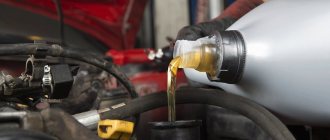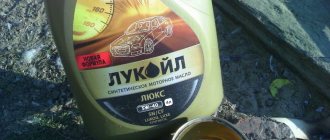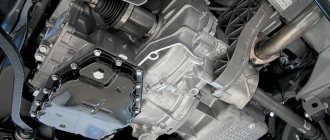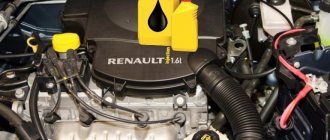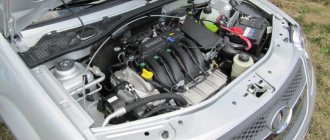Specialists of the domestic automobile industry, in particular the AvtoVAZ concern, are trying to keep up with the times and keep up in the development and production of new modern models. The brightest representative of such movements is Lada Largus. This is a joint development of VAZ together with the giant Renault-Nissan.
What kind of lubricant is poured into the Lada Largus engine
To determine the type of oil that is poured into the Lada power unit, you need to use the standards offered by the manufacturer in the instructions. For example, for those engines designed for the environmental classes Euro 3 and Euro 4, lubricants with a domestic index are chosen:
- AAI-003 B5;
- AAI-003 B6.
If the lubricant is from a European plant, then when choosing, look at the following indices:
- API SL\SM\SN;
- ACEA A1\A2\A3\A5.
In addition to environmental standards, the level of viscosity is taken into account. Experienced mechanics recommend compounds such as:
- 0W40;
- 5W40;
- 5W30.
To determine more precisely which oil is best to use, you also need to pay attention to the area where the car is operated. For example, in cold regions a less viscous lubricant is poured, but in hot regions of Russia it is more viscous.
Lubricant replacement procedure
The lubricant is replaced in a certain sequence. How much lubricant to prepare for this is indicated above. Depending on which engine (8 or 16 valves), the appropriate viscosity is selected. In addition, you must purchase a new oil filter from Renault catalog 7700274177 or 8200768913. You must also have the following materials available:
- container for draining waste substances;
- a set of keys, a filter remover;
- rags and brush;
- tetrahedron by 8.
Next, perform the following steps:
- The car is driven onto an overpass or inspection hole (the engine is warmed up).
- The engine crankcase protection is removed using wrenches.
- The oil pan is cleaned of dirt and other deposits.
- The hood rises and the plug opens, through which lubricant will then be poured.
- The tetrahedron loosens (a couple of turns) the drain plug.
- The container is inserted, the plug is completely unscrewed, and the used lubricant is drained.
- It is necessary to check the condition of the sealing gasket, which, together with the plug, closes the drain neck. If it is unsatisfactory, it will need to be replaced.
- After some time, after the waste material has completely stopped flowing, the neck plug is screwed back on.
- The filter is replaced - the used part is unscrewed using a puller. The rubber seal of the new filter is lubricated with oil, after which it is screwed into place.
- New working fluid is poured through the filler neck. Ideally, about 4.8 liters should enter, but no more. It is advisable to periodically check the level with a dipstick. After this, the neck is closed with a stopper.
- The motor starts and runs to circulate the lubricant throughout the system. When starting, the emergency oil pressure lamp in the engine should go out. After warming up, you need to check the lubricant level again with a dipstick. It should be halfway between the minimum and maximum.
Lada Largus is ready for further trips. You can watch the oil change procedure on video for a better understanding.
What original oil is poured into the Lada Largus engine
Original oils supplied by the Rosneft plant have an optimal ratio of additives and an adequate price. Original lubricants from Rosneft:
- Lada Professional 5 W40;
- Lada Ultra 5 W40.
AvtoVAZ poured the following oils into the vehicle engine:
- Shell Helix HX7 5W 40;
- Lukoil Lux 5 W 30.
Attention! Experienced mechanics recommend changing the lubricant in the power unit after 7,000 kilometers. Since the cleaning properties of modern lubricants begin to decrease after 5,000 kilometers. Together with the engine oil, the filter devices in the engine are changed from the factory.
Brief excursion
In numerous videos presented on the Internet, you can see this car, get acquainted with its characteristics and watch test drives. The spacious interior and large trunk are impressive, which is very useful for Russians - especially those who like to travel outside the city.
In 2010, Lada Largus was first presented to the public. After 2 years, the first car rolled off the assembly line and industrial production began. The car itself is a copy of the Dacia Logan MCV, presented under license for production at AvtoVAZ. Nowadays, several modifications of the Lada Largus are produced: with a station wagon body capable of accommodating 5 or 7 passengers, as well as with an all-metal body and a 2-seater saloon.
The car is equipped with two French injection engines with a volume of 1.6 liters - with 8 valves and a capacity of 87 hp. s., as well as a 16-valve engine with a capacity of 105 horses. A 16-valve engine has two camshafts, an 8-valve engine has one. The car is made on the Renaul Logan platform, and the engines are also taken from there. Transmission – manual 5-speed, French.
In the video you can see how the Lada Largus confidently moves along our roads. This became possible because the suspension, springs and shock absorbers are adapted to Russian road conditions and are designed for increased load capacity. Increased ground clearance also contributes to good cross-country ability.
Lubricant for gearbox Lada Largus
After 90,000 thousand kilometers, car owners first think about what gear oil to pour into the Largus gearbox. Experienced mechanics recommend not to pour the same lubricant into the mechanics, automatic transmission and variator. For different types of gearboxes, lubricant intended only for it is used.
For your information! Unfortunately, many car owners only have a manual transmission installed in Lada Largus. The automaker tried to install an automatic transmission on the car, but the car with automatic transmission never entered mass production.
Although the manufacturer claims that the oil in the box does not need to be changed, experienced mechanics advise regularly replacing it after 90 thousand kilometers. If the car is used in difficult conditions, then the replacement period is reduced to 60,000 km.
When choosing mechanical oil, you need to pay attention to the viscosity and specification. The SAE marking indicates low temperature and high temperature characteristics. In areas with a temperature of at least 26 degrees with a minus sign, lubricant with the index 80W is poured into the manual transmission. Oil with a specification of 75W is poured in regions with temperatures not lower than 40.
The most commonly used oil that is poured into the Lada Largus box is Elf Tranself NFJ 75W-80. The lubricant belongs to class GL 4+. It is approved by companies such as AvtoVAZ and Renault. Oil is added from the factory. But many motorists replace it with analogues. Experienced mechanics advise that when replacing the original lubricating fluid with an analogue, completely drain the used oil and refill with fresh oil.
As analogues, choose the one that is suitable in terms of viscosity and standard. It is not recommended to change mineral to synthetic and vice versa.
What and how to choose?
What kind of oil should I use? To select the correct oil, you will need to study the manual supplied with the car. Its pages display all the required characteristics and properties of the lubricant.
To replace, you will need to contact a dealer service station. If the car’s warranty period has already expired, then such a replacement can be carried out independently or with the help of service technicians. The procedure itself is not complicated and does not require any secret skills.
The system filter must be replaced at the same time as the oil. Based on the characteristics and properties of the lubricant regulated by the manufacturer, we can safely consider the following products:
- “Shell” with the following viscosity and temperature parameters “5W–40”;
- "Valvolin" with "5W-30";
- "Gulf Formula G", has the characteristics of "5W-40";
- "ZIC A+" with "10W–40".
What is important besides changing the lubricant in the engine and manual transmission
Many car enthusiasts do not like to look under the hood before changing the lubricant. The fact is that during operation, rubber gaskets and seals can harden and leak oil. As a result, lubricant loss begins in these devices. The level decreases, which leads to strange behavior of the car on the roads and ultimately to major repairs.
To prevent this from happening, experienced mechanics advise:
- every 5,000 kilometers check the lubricant level in the engine;
- Every 30,000 kilometers, check the oil level in the manual transmission.
Such simple measures will save the car owner from wasting money. If necessary, it is recommended to add oil to the gearbox or power unit. The engine and manual transmission are pre-serviced. A technical inspection is needed to detect faults that lead to loss of lubricant.
What harms the normal long-term operation of the rubber parts of the engine and mechanics:
- daily delays in traffic jams. The oil in the power unit and gearbox heats up and then cools down; the oil seals expand and contract at a constant frequency, which leads to their wear. And the lubricant itself quickly loses its properties in this case;
- starting the engine cold;
- Frequent travel over short distances. The liquid does not have time to really warm up. Condensation forms. This happens very often in winter.
And condensation dilutes the lubricant, and it loses its protective properties.
What to look for when choosing
Before pouring oil into the Lada Largus, you need to remember that no matter what lubricant is used, there is no fundamental difference in the number of valves - it “works” equally well on both engine options.
Therefore, first of all, it is necessary to decide on the composition. This definition depends on the operating mode of Largus. If the car will be used daily, then it is worth pouring into such a car oil created on the basis of conventional or hard hydrocracking.
In simple terms, we are talking about synthetic lubricant and semi-synthetic lubricant, respectively. You can also use mineral oil, but you will have to change it more often.
If Lada Largus is driven at high speeds, then it is necessary to use lubricants based on esters or PAO. As for mineral oils, they are completely unsuitable for such operating modes.
Technical features of K4M
The monolithic cylinder block of the Renault K4M engine is made of cast iron. It has an in-line arrangement of four cylinders. The piston group is reinforced with steel inserts in the area where the compression rings are installed. The fixing piston pins are pressed tightly into the upper heads of the connecting rods, and are installed in the piston bosses with a gap. The piston weight is 450 grams, with a diameter of 79.465 - 79.475 and a compression height of 31.7 mm. The internal combustion engine uses forged steel connecting rods with the following dimensions (mm):
- 128 – length
- 47.612 – 47.627 – bottom head hole diameter
- 19.945 – 19.958 – diameter of the upper head hole.
K4M without valve cover
The cylinder head is made of aluminum. A belt is used to drive the timing mechanism. The engine is equipped with sixteen valves and two lightweight steel camshafts. Cams are pressed onto them.
The intake and exhaust valve plates are manufactured with a diameter of 32.5 and 28 mm, respectively. The length of the rods in millimeters is:
- 109.32 – intake
- 107.64 – exhaust valve.
Pistons with connecting rods K4M
In this case, the diameter of the rods is the same and equals 5.5 mm.
Compliance with the established criteria for environmental standards is ensured through the use of a phase regulator.
About choosing a filter
The oil filter on the K4M engine must be changed at every oil change. This requirement is more stringent than for 8 valves. On an 8-valve engine, the filter can be replaced “every other time,” although this is contrary to the regulations. But the 16-valve engine is not ready for such “difficulties”.
Articles
The Renault catalog contains two designations - 7700274177 and 8200768913. These are the article numbers for oil filters. But they differ - the first, “shorter” filter comes from the factory.
Filters 7700274177 (left) and 8200768913 (right)
Filter housing height:
- 7700274177 – 49 mm;
- 8200768913 – 53 mm;
- 7700873603 – 55 mm.
You can try the third option at your own risk.
Selection of analogues
- VALEO 586001
- AMC MO441
- GoodWill OG-313
- MecaFilter ELH4196
- Logem LRT-328
- MANN W75/3
Show hidden content
- BASBUG BSV7700274177
- MAHLE OC467
- FEBI 27155
- FILTRON OP643/3
- BOSCH 0 451 103 336
- ASAM 30097
- FORTECH FO-018
- PATRON PF4032
- MEYLE 16-14 322 0000
- COOPERSFIAAM FT5902
- MFILTER TF 46
- UFI 23.418.00
- FRAM PH5796
- BLUE PRINT ADC42115
- PURFLUX LS932
- HENGST H11W02
- CHAMPION F136/606
- LYNXauto LC-1400
- CUMMINS HF7615 or LF3494 or LF3714 or LF798
- FORD 5013388 or 5006227
- DEUTZ-FAHR 12850312 or 1052175136
- LIGIER 112397
- NISSAN 15208-00Q0D (H/N/F)
- ALFA ROMEO 0073500506
- MAZDA AM1514302 (55 mm)
- Nevsky filter NF-1018
Oil change intervals
The frequency of oil changes in the Lada Largus engine is 15 thousand km. However, when making calculations, individual factors that influence the production of lubricating fluid should be taken into account:
- duration of trips around the city, frequency of stops and turns;
- aggressive driving style, high speeds;
- environment, annual and daily temperature changes;
- dustiness of roads, their surface, slipping.
All this can reduce the service life of the lubricant to 10 thousand km. In this context, regular oil checking becomes recommended. Its implementation will allow us to determine the frequency of lubricant replacement at an individual level.
The consequences of untimely oil changes are related to its functionality. In addition to lubricating mechanisms, this liquid provides heat and work product removal. Increased engine overheating will be the first consequence of its expired service life.
When heated, the working parts will begin to wear out faster, which will increase sediment and impurities in the circulating fluid. This will lead to clogging of the filter and reduce its throughput, which will cause oil starvation in the main engine components.
Further consequences depend on the total mileage of the vehicle and the service life of its components. The older the parts, the faster they will begin to fail and the larger the subsequent repairs will be.


